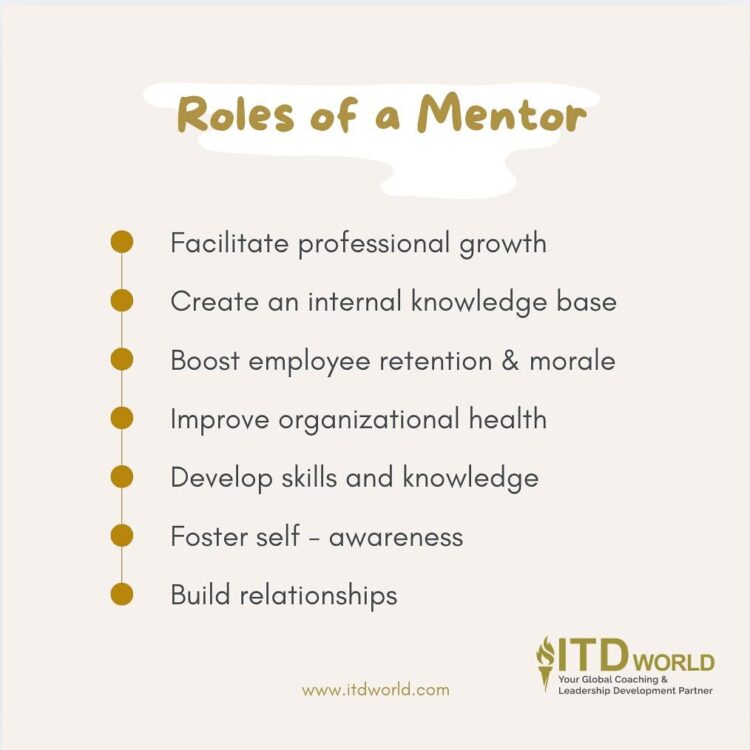Mentoring is increasingly used in organizations across industries to enhance capabilities, improve competencies, and heighten performance. It has become a key strategic tool for leaders to engage and enable their team members for breakthrough results. When leaders mentor others, they are teaching or advising someone else to pick up a skill, or to gain expertise in a particular topic. The core purpose here is to drive the growth and development of the one being mentored.
|
Author: Aaron Ngui |
What is Mentoring?
Mentoring is defined by the dictionary as advising or training someone. Usually, the mentor-mentee relationship is perceived as an older person guiding someone younger.
In their book Becoming an Effective Mentoring Leader, Penn State Professor Dr. William Rothwell and ITD World CEO Dr. Peter Chee shared their initial definition of a mentor as “an advisor and teacher, inspirer, motivator, and encourager” – which was coined after interviewing numerous people across various organizations.
After some reflection and refinement, both finalized the definition of a mentor as “an enabler and uplifter”. Specifically, a mentor’s role is to enable the other person (mentee) to achieve their goals through teaching, advising, and inspiring them to continuously forge ahead.

Examples of Mentoring
- A professionally qualified engineer could be guiding a junior engineer in repairing a particularly tricky piece of machinery;
- A software architect may be teaching his team the ins and outs of Phyton; or
- A cub reporter is tailing a senior reporter for her first-time coverage of a Parliamentary session.
All of the above-mentioned scenarios possibly involve a mentor-mentee relationship, where someone who is more knowledgeable, skilled, or experienced, is showing the ropes to someone more junior.
Nonetheless, this may not necessarily be the case all the time – as younger team members can also mentor upwards (sometimes referred to as “upwards” or “reverse” mentoring). For example, a new employee could be well-versed in Search Engine Optimization (SEO) and so may be asked to mentor an older colleague on the techniques used. Such scenarios are usually observed when it comes to the use and leveraging of new technological platforms for business outcomes.
What Does a Mentor Do?
A mentor is someone who sees more talent and ability within you, than you see in yourself, and helps bring it out of you.
Bob Proctor
A mentor acts as a guiding force in a person’s life – someone who takes on the responsibility of helping their mentee achieve their goals and unleash their fullest potential. Their role is multifaceted and dynamic, encompassing various aspects of personal and professional development:
-
Teacher
One primary role of a mentor is that of a teacher – one who shares their knowledge and expertise, whether it’s in a specific field, industry, or area of life. They offer guidance and instruction to help their mentees acquire new skills/ enhance existing ones. This teaching can take the form of formal lessons, hands-on training, or simply imparting wisdom through storytelling and conversation.
-
Counselor
Mentors also act as counselors, offering emotional support and guidance to mentees when they are facing challenges to success. In such moments, their job is to provide a listening ear, empathy, and advice to help mentees navigate personal and professional dilemmas.
-
Role model
By demonstrating the behaviors, attitudes, and ethical principles required for success, mentors set a powerful example for their mentees to follow. Through their actions and choices, they inspire those under their guidance to strive for excellence, integrity, and professionalism. A mentor’s life experiences and achievements serve as a testament to what can be accomplished through hard work, determination, and perseverance.
-
Advocate
Mentors make use of their influence, connections, and knowledge of the mentee’s strengths to create opportunities. Whether it’s introducing them to key figures in their industry, recommending them for projects, or endorsing their skills and abilities, they help open doors that might otherwise remain closed.

What to Expect from Mentorship
- Feedback for personal development
Mentors’ role is to provide constructive criticism, pointing out areas for improvement – while also highlighting the mentee’s strengths. This feedback loop is crucial for the latter to refine their skills, gain self-awareness, and build confidence.
- Networking opportunities
Mentors excel at expanding their mentee’s horizons through networking. They introduce mentees to their professional circles, fostering connections that can be invaluable in various aspects of life. These networks facilitate learning, collaboration, and access to new career opportunities that may contribute to one’s personal and professional advancement.
- Support
During challenging times, a mentor’s encouragement serves as a pushing force for mentees to persevere through setbacks. Whether it’s a listening ear, a motivational pep talk, or assistance in problem-solving, the former ensures the latter don’t feel alone on their journey.
Mentoring vs Coaching
Mentoring and coaching are two important forms of professional development that are often used in combination with each other. While there are some similarities between the two, they also have some key differences.
At a basic level, mentoring is typically seen as more long-term and focused on providing guidance to help someone reach their full potential. This may involve sharing knowledge and expertise, helping to build skills and competencies, or offering support and advice through difficult challenges or transitions. In contrast, coaching tends to be more focused on short-term goals, such as developing specific skills or improving performance in specific areas.
Another key difference lies in their respective relationship dynamics. Mentors usually come with more experience and seniority, and are often viewed as more of a “guide” or “teacher”. By contrast, it is perfectly normal for coaches to have less experience and authority.
| Feature | Mentoring | Coaching |
| Focus | Long-term development, reaching full potential |
Short-term goals, specific skill development
|
| Timeframe | Typically longer term |
Typically shorter term
|
| Relationship | Mentor is usually more experienced/senior, acts as a guide/teacher |
Coach may have less experience/authority
|
| Emphasis | Guidance, knowledge sharing, support, advice |
Skill development, performance improvement
|
Read more: Coaching vs Mentoring – Define the Differences
Purposes of Mentoring – Reasons to Engage in Such a Relationship
Some may question why they should be spending their time and effort on helping others become better. “If I help others gain skills, am I not just helping the competition to overtake me?” may be their argument. In fact, various research and observations have demonstrated the various benefits one may enjoy when taking on the role of a mentor – including:
- Opportunity to make more money than those who don’t.
- Get promoted more often.
- Enjoy greater career success.
- Gain satisfaction and pride in developing others.
- Win the respect of people.
- Enhance their own reputation.
- Learn new things from the mentee.
- Build a support network of past and current mentees.
- Improve mental health and well-being.
For those on the other side of the spectrum, they also receive a lot in return – namely:
- Support and encouragement in a professional setting.
- Increase collaboration within the department or across functions.
- Advice on navigating tricky situations.
- Gaining knowledge on leadership from established leaders.
- Refine their interpersonal and leadership skills.
- Receiving feedback and feedforward for closing the gaps.

The Importance of Mentoring in the Workplace
- Facilitate professional growth
Mentoring transforms the workplace into a thriving hub of skill development and knowledge exchange. For mentors, it offers an opportunity to practice their own skills – while at the same time enhancing their mentees’ capabilities. This process cultivates a pool of highly skilled and experienced members who can contribute to the company’s productivity, efficiency, and innovation.
- Create an internal knowledge base
Experienced employees act as living libraries of knowledge within an organization. They eliminate the need for external training partners to educate new hires on equipment operation or specific processes – for they can conduct in-house training themselves. This internal knowledge base reduces training costs – as well as eases the learning process for newcomers.
- Boost employee retention & morale
Employees who benefit from mentorship tend to be more satisfied with their jobs and overall work experience, making them more likely to stay with the company. This, in turn, helps create a positive and supportive work environment, leading to reduced turnover. In fact, according to a CNBC survey, 91% of workers with a mentor reported job satisfaction, compared to 70% without one. Additionally, 40% of those without a mentor had seriously considered quitting in the past three months, compared to 25% of those with a mentor.
- Improve organizational health
By involving team members in decision-making and problem-solving processes and providing them with support and guidance, mentoring enhances motivation, engagement, and overall performance. Additionally, it strengthens communication and relationships among team members and between employees and managers.
Mentoring also offers a unique opportunity for leadership development. Those serving as mentors are provided with the opportunity to refine their leadership, communication, and coaching skills – while also gaining fresh perspectives from their mentees. This process encourages a learning-oriented mindset among leaders and empowers employees to create and share their practices and resources.
A mentor is someone who allows you to see the hope inside yourself.
Oprah Winfrey
Why Mentoring is a Cornerstone of Leadership
- Developing skills and knowledge
Leadership is not static; it requires constant evolution and adaptation. Through mentorship, leaders gain access to a wealth of experience and expertise, helping them become more effective and successful in their roles.
- Fostering self-awareness
Mentors play a critical role in helping leaders reflect on their strengths and weaknesses. By facilitating this introspective process, leaders are better equipped to recognize areas where they can improve, ultimately enhancing their capacity to lead with authenticity and impact.
- Building relationships
Leadership is inherently relational, and mentors assist leaders in forging meaningful connections – including colleagues, team members, and various stakeholders. These connections are fundamental for fostering trust, collaboration, and effective communication within an organization.
- Navigating challenges and setbacks
In moments of uncertainty and adversity, mentors provide a steady hand and a wealth of experience to draw from. They offer guidance on how to navigate complex situations, make informed decisions, and persevere through tough times.

Types of Mentoring
At ITD World, our experts – Dr. Rothwell and Dr. Chee – advocate the existence of three types of mentors, namely:
-
Reflective mentor
The first involves a leader who reflects on the lessons of their experience to benefit the mentee. This means they want to pass on the right lessons to others, and not help their mentees circumvent ethical or legal norms. In other words, if the mentor has no qualms about doing it, then he or she should have no issues sharing what they know.
-
Mentoring by example
In this case, mentors take a more hands-on approach – they may include the mentee indirectly or directly in an activity, and try to gradually get them familiar with their duties, roles, and responsibilities before ultimately handing them the reins.
For example, a teacher may take a trainee teacher to the class for them to see how it is done. After a couple of lessons, they may ask the trainee to help in preparing the lessons. When the trainee gets comfortable being in class and gets the feel of preparing lessons, the teacher may then ask them to lead activities before eventually taking over the class.
Read more: Leading by Example – Key to Truly Inspiring Action & Trust
-
Storytelling mentor
Here, leaders come up with stories with learning points so that they can pass on values and principles to their mentees. The stories they share are based on their experiences – all of which come with a moral for learning.
For example, a sales director may share with his team how she managed to overcome resistance from decision-makers to close a million-dollar sale. Or, a senior real estate agent may share a funny anecdote with new agents on how to quickly establish rapport and trust with potential clients.
Although entertaining, the main thrust of using stories is to ensure the lessons are delivered in an engaging and memorable format, one that the mentee can easily remember.
Mentoring Models
- One-on-One mentoring
The classic and perhaps most recognizable form involves a singular mentor guiding and supporting a single mentee. In this model, both parties typically share common interests, goals, or backgrounds. Regular one-on-one meetings create an intimate and focused environment for in-depth discussions, progress assessments, and targeted problem-solving.
- Group mentoring
Here, mentorship is extended to multiple people, often facilitated by one or more mentors. The beauty of this approach lies in the diversity of perspectives it offers. Mentees may have varied interests, goals, or backgrounds, allowing for rich exchanges of ideas and experiences within the group.
- Peer mentoring
With this model, those of similar experience or expertise levels are placed in mentorship relationships. As a result, it results in a sense of equality and camaraderie, with peers sharing knowledge, feedback, and encouragement as they learn together.
- Reverse mentoring
In this arrangement, a younger or less experienced individual takes on the role of the mentor for an older or more experienced counterpart. Cross-generational learning and the exchange of fresh perspectives and insights are encouraged. The approach challenges traditional hierarchies, fostering a more inclusive and innovative environment.
- E-mentoring
E-mentoring harnesses technology to facilitate mentorship – so that people may communicate through email, video conferencing, or online platforms. The advantage is that those with different interests, goals, or backgrounds may now have the chance to engage in a flexible and adaptable learning experience.
- Blended mentoring
In this case, elements from multiple mentoring models are combined to create a customized approach. Mentor and mentee profiles can vary widely, accommodating different interests, goals, or backgrounds. The blended approach leverages various communication methods and modes, allowing for a versatile and personalized mentorship journey.
Read more: Learning & Development – Asset for Long Term Growth

5 Stages of Mentoring
-
Establishing the relationship
The mentor and mentee should start by getting to know each other, both personally and professionally. This can be achieved through casual conversation or more formal meetings. The relationship may also involve setting up ground rules – the mentor may want to outline goals they have, while the mentee can explain their expectations of the relationship.
-
Setting expectations
Once a foundation is established, the two need to discuss what each person hopes to get out of this relationship. It’s essential that both parties are on board with these goals from the beginning – so that there are no disappointments later on if things don’t go according to plan.
For example, one who expects to receive significant career advice may not be as interested in the mentor’s personal life, while one who’s looking for emotional support may be less concerned about professional advice.
-
Working together towards a common goal
Once expectations are set, it’s time to work together and come up with action plans that will help visualize them. For example, the mentor might encourage their mentee to explore new opportunities – or suggest ways they can improve their networking skills. The mentee could then take these suggestions and report back on their progress at future meetings.
-
Review & reflection
As the relationship progresses, it’s essential for both parties to reflect on whether they’re progressing toward their goals – this is also an opportunity for any necessary adjustments to be made.
-
Coming to closure
Eventually, the relationship will come to an end – either naturally or by choice. In either case, both parties are encouraged to reflect on all that was learned during this time, perhaps even writing up a personal development plan based on what has been accomplished through the journey.
Mentoring Techniques
Effective mentoring often combines a variety of techniques in a flexible and context-specific manner – so as to contribute to a dynamic and supportive relationship:
- Goal-setting
Goal-setting is a fundamental technique in mentoring. Mentors assist mentees in defining both short-term and long-term goals. This involves helping them identify their interests, values, strengths, and aspirations. Together, both work on a structured plan of action, breaking down larger goals into manageable steps.
- Feedback
Constructive and timely feedback is a cornerstone of effective mentoring. Mentors offer feedback on the mentee’s performance, behavior, and overall development – which enables the latter to gain awareness of their accomplishments, pinpoint areas for improvement, and list down challenges they may encounter.
- Modeling
Modeling is a technique where mentors demonstrate desired skills, attitudes, or behaviors for mentees to observe and emulate – as well as explain the reasoning behind their actions. Through modeling, mentees gain a clear understanding of how to perform certain tasks or exhibit specific behaviors. They can then practice what they’ve learned and receive input, further fostering skill development and personal growth.
- Questioning
Mentors ask open-ended questions that stimulate mentees’ curiosity and promote deep exploration. By encouraging them to examine their options, assumptions, and perspectives, mentors guide them in making informed decisions and gaining clarity about their objectives.
Read more: 60 Key Questions to Ask as a Mentor
Active listening involves paying full attention to what the mentee is saying, both verbally and nonverbally. Mentors are expected to create a safe and open space where mentees can express themselves without fear of judgment.
Mentoring Principles to Keep in Mind
Before jumping straight into a relationship, both the mentor and mentee should consider the following success factors.
- Ability
Is the mentor suitable for the mentee or vice versa? A mentor may not have the knowledge or skills to help the mentee grow. On the other side, the mentee should consider choosing a mentor that can help achieve their aims.
Either way, both sides would want to have an honest and open discussion on working collaboratively for mutual benefit.
- Time
Mentors may be busy people with heavy workloads, in addition to their business travel and family commitments. As much as they are willing to be a mentor, time may not permit them. Be realistic with the time required for a fruitful relationship.
Nonetheless, no one is busy all the time; as such, the mentor can say yes when they eventually have the time, or the mentee can approach again when the time is right.
- Values
Values are what people consider important in work and life. If the mentor and mentee have different values, then the possibility of an unsuccessful relationship is very high. In such cases, both sides should be mature enough to part ways amicably.
The delicate balance of mentoring someone is not creating them in your own image, but giving them the opportunity to create themselves.
Steven Spielberg

Mentoring Skills
Although not an exhaustive list, here are five skills one would want to refine in order to improve mentorship:
- Give clear advice: Mentors who can do this are highly valued, as the guidance they provide is actionable and can be put to good use by the mentee.
- Control personal bias: Everyone has their own set of preferences. The ability to put aside, mitigate, or control our personal tendencies is crucial for the relationship to stay on a strong footing – as uncontrolled biases often result in premature conclusions and negatively impact the situation.
- Show positive regard: As mentioned earlier, a mentor is someone who uplifts others. No one can be a positive encourager if they do not regard others in a positive light.
- Inspire trust: Trust and integrity serve as an important ingredient in a mentoring relationship. If the mentee does not trust his or her mentor, the relationship will be unfruitful and both sides will just waste their time.
- Politically savvy: This does not mean the mentor and mentee are playing political games in the office. Rather, the former should have the political nous to support the latter in connecting them with others to help them achieve their goals.
Tips for Being a Good Mentor
- Be an active listener. Mentors who do their best to listen to what their mentee wants tend to perform better as they can respond accordingly. To be a good listener means to pay full attention to what is being said and not get distracted by inner thoughts or the environment.
- Be self-confident. Mentors should have confidence in their abilities – otherwise, why should others place trust in them? Having confidence in their own capabilities also builds faith among the mentees – that they have made the right choice.
- Have a sense of humor. Everyone experiences bad times occasionally. A kind word delivered with humor may be just the pick-me-up people need when they are feeling down. Also, stories delivered with a laugh are more memorable than a serious lecture.
How You Learn From Your Mentors
A mentoring relationship is a two-way street. The mentee should not throw all the responsibility for their own growth and development on the shoulders of the mentor. Instead, they should also shoulder the load of achieving their goals in entering a mentoring relationship.
First things first, one should be clear on what their goals are in seeking out. Once fully aware of what we want, we can then move to identifying who we want to learn or get advice from.
Aside, we may realize the need to get in touch with a variety of mentors – as one size does not fit all. Be open to seeking out those who are willing to support us in visualizing our goals.
When an agreement is reached to enter into a mentoring relationship, one should be civil and respectful of the mentor’s time and effort. This means coming to the meeting prepared with an agenda, note-taking tools, the necessary documents for review, questions, and anything else that can create a fruitful use of time.
How to Find a Mentor
Potential mentees would want to be aware that mentoring can take place either formally or informally. In organizations where formal mentoring happens, there usually exists a system and processes in place for those interested to identify people they want to be mentored by. Otherwise, the simplest approach is to ask people if they are willing to be mentors – if the answer is positive, be prepared to grow and develop together.
Alternatively, there are also those who want to be mentored by someone outside their organization. Those interested can leverage and tap on ITD World’s wide network of experts to enrich them for outstanding results.

Discover ITD World’s Mentoring Programs
At ITD World, we offer a wide range of mentoring programs designed to empower individuals and organizations to achieve excellence in leadership, coaching, and mentoring. Our solutions are thoughtfully crafted to meet the diverse needs of professionals seeking to enhance their leadership and mentoring capabilities:
- Certified Coaching & Mentoring Professional (CCMP): CCMP is a comprehensive certification course designed for those who aspire to become skilled coaches and mentors. The program equips participants with the knowledge, skills, and tools needed to hone their coaching and mentoring expertise.
- Certified Master of Leadership (CML): CML is an advanced leadership development program that not only focuses on leadership skills – but also incorporates coaching and mentoring as integral components of effective leadership. Participants in this program gain a deep understanding of leadership theories, practices, and frameworks while also learning how to leverage coaching and mentoring to inspire and guide their teams.
Aside, we also offer customized in-house solutions tailored to the specific needs and objectives of organizations. These programs are delivered through a combination of workshops, coaching sessions, and ongoing support to ensure sustainable and measurable results.
Contact ITD World today for a FREE consultation!
Other resources you might be interested in:
- Mentoring Quotes: Lessons Learned, Inspiration Shared
- Life Coaching: Key to Finding Purpose & Fulfillment in Life
- Team Coaching: Guidelines for Building High-Performance Groups
- 20 Best Coaching Books: Level Up Your Life for Breakthrough Success


